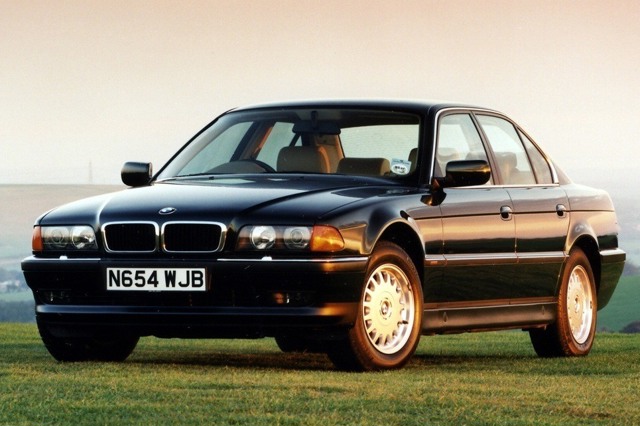BMW 7-series E38 (1994 – 2001) Buying Guide
Good
7-Series was 15th from top in 'R' reg J.D. Power Customer Satisfaction Survey (but well below Jaguar XJ8). S and T reg cars came fourth in 2001 Top Gear / JD Power Customer Satisfaction Survey. BMW, Toyota and Ford jointly suffered the fewest breakdowns attended by German ADAC during 2001. BMW had sixth lowest average cost in warranty claims for cars up to 10 years old in 2002 Warranty Direct index. Low 3 out of 9 point death rate from accidents in this model. BMWs generally had below average warranty repair costs in 2003 Warranty Direct Reliability index (index 81.41 v/s lowest 31.93). Link:- www.reliabilityindex.co.uk
Support website www.e38.org
For servicing and repairs: Independent BMW Specialists Register
Bad
Not a big improvement on 6 cylinder predecessors.
Premature bore wear can be a problem on the earlier M60 V8 engines and the M52 2.8 six. Ticking noise from hydraulic lifters of M52 2.8 six can denote that the oil pump plastic impeller has failed. Unfortunately it's an engine out job to get at it and replace it.
Heavy tyre wear.
Pre-November 2001 3 year warranty required expensive top up to be comprehensive in 2nd and 3rd years.
1994-2002 7 Series 4th least reliable car in 2005 Warranty Direct Reliability Survey with 57 repair claims per 100 cars. Link:- www.reliabilityindex.co.uk
Watch
Build date from 2001 shown on engine compartment label on top of front nearside wheelarch.
Be very wary of M60 730i and 3,982cc 740i V8s (the engines that were dropped in 1996). Some unsold 'P' platers still had the old engines. 728i may also suffer bore liner degradation.
Check all electrics, computer (see 5-Series) and aircon system carefully.
Check for duff cats, condensation corroded rear silencers from chauffeured cars. Chauffeured cars also most likely to suffer premature bore wear due to long periods spent idling. Solved by replacement block with steel-lined bores. UK imports from March 1998 fitted with steel- or Alusil-lined bores, but grey imports from other markets may not be.
Automatic transmission specialists don't like the 5-speed autobox.
1998: new 7s built before Nov '94 recalled to fit new radiator cap (very few cars involved, because new 7 not launched until August 1994).
Failure of seals of rear tail lights lets water in which causes the contact between bulb holder and bulb to erode and contact to be lost. BMW replacements from a dealer are £280 a side, fitted. 1998-2000 rated average for problems and faults, poor for breakdowns in 2003 Which survey.
General Warning about Automatic Transmissions: Many BMWs have "sealed for life" automatic transmissions (this applies to all of the E38 series with the exception of the 730i and many 5 series and also current cars). Regardless of whether you have a full BMW service history, the dealer will never change the auto fluid. Many of these boxes are failing around the 120-150k mark - often well outside of warranty and to a cost of £3.5k plus VAT. A good independent or automatic transmission specialist can and will change the fluid for you (and any good BMW independents will recommend this anyway), but the job has to be done properly with the ATF at the right temperature. This is commonplace in the US and means the box should last the life of the car rather than being the cause of it being written off. General advice is ensure the fluid is flushed out every 60k or more preferably at each Inspection II.
Poor throttle response in a 728i may be due to faulty camshaft sensor.
Build date from 2001 shown on engine compartment label on top of front nearside wheelarch.
Be very wary of M60 730i and 3,982cc 740i V8s (the engines that were dropped in 1996). Some unsold 'P' platers still had the old engines. 728i may also suffer bore liner degradation.
Check all electrics, computer (see 5-Series) and aircon system carefully.
Check for duff cats, condensation corroded rear silencers from chauffeured cars. Chauffeured cars also most likely to suffer premature bore wear due to long periods spent idling. Solved by replacement block with steel-lined bores. UK imports from March 1998 fitted with steel- or Alusil-lined bores, but grey imports from other markets may not be.
Automatic transmission specialists don't like the 5-speed autobox.
1998: new 7s built before Nov '94 recalled to fit new radiator cap (very few cars involved, because new 7 not launched until August 1994).
Failure of seals of rear tail lights lets water in which causes the contact between bulb holder and bulb to erode and contact to be lost. BMW replacements from a dealer are £280 a side, fitted. 1998-2000 rated average for problems and faults, poor for breakdowns in 2003 Which survey.
General Warning about Automatic Transmissions: Many BMWs have "sealed for life" automatic transmissions (this applies to all of the E38 series with the exception of the 730i and many 5 series and also current cars). Regardless of whether you have a full BMW service history, the dealer will never change the auto fluid. Many of these boxes are failing around the 120-150k mark - often well outside of warranty and to a cost of £3.5k plus VAT. A good independent or automatic transmission specialist can and will change the fluid for you (and any good BMW independents will recommend this anyway), but the job has to be done properly with the ATF at the right temperature. This is commonplace in the US and means the box should last the life of the car rather than being the cause of it being written off. General advice is ensure the fluid is flushed out every 60k or more preferably at each Inspection II.
Poor throttle response in a 728i may be due to faulty camshaft sensor.
Recalls
15/12/1999: (E38 built Sept/Oct 1999): brake light switch may fail leading to brake lights flickering or failing and switch overheating. New switches to be fitted.
16/11/2001: cars built 11/11/2000 - 30/9/2001 recalled because fault with radiator fan motor could lead electrics to overload, fan motor to fail and a small electrical fire to result.
10-7-2002: Due to an ECU software error, fuel pump may not work fast enough once fuel level in tank is below 30 litres. 832 cars affected. ECU to be reprogrammed.
28/2/2003: Possible leak from PAS. Check union bolts for leakage. Leaks found, steering rack to be replaced. No leaks, unions to be tightened to correct torque.





 Luxurious and capable, with a comfortable ride and decent handling.
Luxurious and capable, with a comfortable ride and decent handling.
 Hard on tyres. Afflicted by wide-ranging niggles and problems. Bore liners of early V8s can degrade.
Hard on tyres. Afflicted by wide-ranging niggles and problems. Bore liners of early V8s can degrade.

